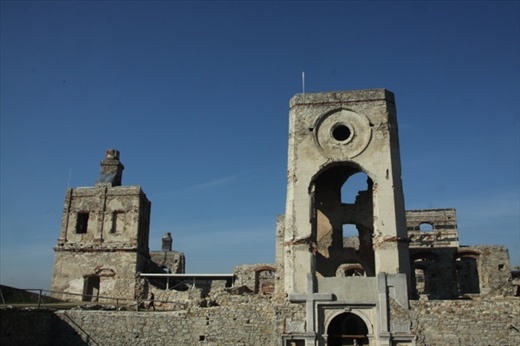Zamość is a World Heritage site. Sandomierz is not. Zamość has existed pretty much unchanges since the 16th Century. Sandomierz has been sliding downhill literally! The sun was shining on Zamość. Sandomierz was cloaked in fog. But each was interestiing in its own way and neither has as many tourists as it deserves.
Zamość, the personal creation of the Hetman (head of the army) Jan Zamysky, is a blend of Italian and central European architecture. Located on the trade route linking western and northern Europe with the Black Sea, the town was conceived from the beginning as an economic centre based on trade. Many of the buildings on the central square bear the names of their affluent owners. Others have names like "Under the Angel" house, "Married Couple" house and "Madonnal" house.

City Hall, Sandomierz
The morning sun was replaced by heavy fog as we climbed the hill to Sandomierz with its impressive Gothic town hall propped upright in its center. There were nice building painted in warming hues of brown, orange, and yellow, many festooned with elegant wrought iron balconies, line the streets. The town dates to the 11th century as a major settlement of the Polish kingdom, along with Krakow and Wroclaw. Sandomierz was rebuilt in the 1260s after a battle with the Tatars. and prospered until the mid-17th century when Swedes invaded and the town hasn’t recovered since. After having survived WWII unscathed, the next threat came in the 1960s when its most significant buildings stared to slide into the river. The ground was stabilized and the town’s architecture was saved.

Krzyztopor Castle, one man's whim
Not all sites are worth the effort. Take Krzyztopor Castle, for instance. The castle was designed by governor Krzyztopor Ossolinski in 1361 to embody a calendar. It sports four towers representing the four seasons, 12 halls for the 12 months, 52 rooms for the 52 weeks of the year, and 365 windows with one extra to be used only during leap year. The cellars were used as sables for the owner's 370 while stallions and were adorned with mirrors and black marble. It hasn’t been inhabited since 1770, and looks it. There seems to be some work being done on the castle, but entropy seems to be winning out. And they say that Ludwig was mad.